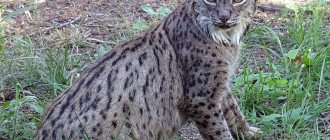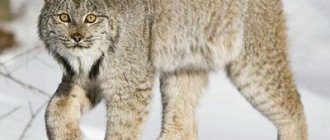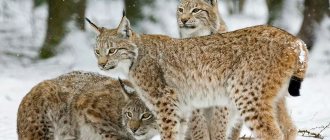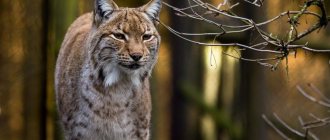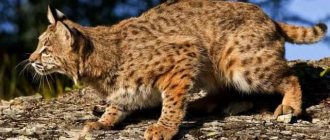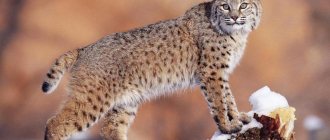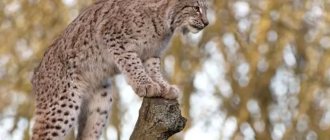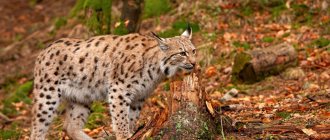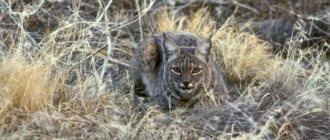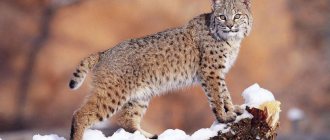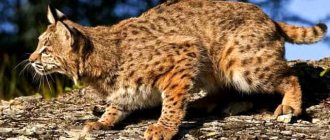- Wild animals
- >>
- Mammals
The cat family is represented by a wide variety of animal species. The Canadian lynx is considered one of the most spectacular and graceful . This is a very beautiful and incredibly majestic animal. The lynx is by nature an excellent predator. These felines have very sharp teeth and claws, giving them a deadly grip. Another feature of this animal is its very long and fluffy fur, because of which the species was almost on the verge of complete extinction.
Origin of the species and description
Photo: Canada lynx
The Canadian lynx is a chordate animal. It is a representative of the class Mammals, the order Carnivora, the cat family, the genus Lynx, and the species Canadian lynx.
Today, the population of Canadian lynxes is small, and of the previously existing seven subspecies, only two remain:
- L.c. Subsolanus live in Newfoundland;
- L.c. canadensis is found in the Northern USA and Canada.
The exact period of appearance of lynxes has not yet been established. The remains of ancient ancestors and mentions in chronicles indicate that these amazing cats lived on earth many millions of years ago.
Zoologists call the ancient cave lynx the ancestor of the modern lynx. It inhabited the territory of modern East Asia, the Caucasus, the Mediterranean, and other regions in the Pliocene. Cave lynxes were similar to modern ones, but they were still very different in appearance. They had a long, elongated, not so muscular body. The tail of ancient cats was not so short, and the limbs were not so long. The overall dimensions were much larger than those of modern individuals. In the process of evolution, the limbs became longer, their supporting area increased, the tail became shorter, and the body became less elongated.
In the 18th century, people began to kill animals en masse, in very large quantities. Their numbers were reduced to a minimum in a short time. Animals are on the verge of complete extinction in some regions.
Appearance and features
Photo: Canadian lynx in nature
The appearance of the Canadian lynx is truly impressive. Compared to other types of lynx, Canadian cats have more modest body dimensions. The body height of the animal at the withers is 60-65 centimeters, and the length is from 80 to 120 centimeters. Body weight ranges from 7 to 15 kilograms. Animals exhibit sexual dimorphism. Female individuals weigh approximately 5-11 kilograms, while male individuals weigh from 7 to 13 kilograms.
Features of the Canadian lynx:
- elongated, elongated tassels on the ears made of wool. The length of the tassels is about 5-6 centimeters. The triangular-shaped ears are not too large, but slightly tilted forward;
- the presence of fluffy sideburns on the face. In the cold season, they become thicker and longer, even covering the neck area;
- round pupils;
- shortened muzzle;
- powerful, strong limbs with well-developed muscles. It is in Canadian lynxes that the hind limbs are slightly longer than the front ones. Such strong, powerful limbs contribute to an even distribution of body weight;
- very thick and long hair that protects the animal’s body in the cold season and prevents loss of moisture in the summer heat.
The tail of Canadian lynxes, like other species, is short and stubby. It always ends with a black tip. The predominant color of the European lynx is reddish-brown. In summer, during the warm season, the color has a yellowish tint. In winter, the coat becomes a dirty gray color.
The back always has a darker shade. The belly is lighter in color relative to the rest of the body and limbs. Most individuals have dark spots on the body. The jaws of these representatives of the cat family have 28 teeth, four long fangs and four carnassial teeth, with the help of which the predator crushes and grinds its food.
Interesting fact: Fangs are riddled with nerve endings, thanks to which animals are able to sense exactly where they bite their prey.
This jaw structure and large number of nerve endings leave the victim no chance of salvation.
Features of keeping as a pet
The Canadian lynx is an absolute predator; living in an apartment is strictly excluded. Some exotic lovers want to get a Canadian lynx as a pet. In this case, it is important to remember that such animals can only be in a private house with a large local area. In addition, it is preferable to organize an outdoor enclosure for the Canadian lynx, where it will feel especially comfortable in winter.
Caring for a lynx is not particularly difficult. It is important to provide the animal with living conditions that are as close as possible to their natural environment. It is recommended to feed the lynx raw rabbit meat, herbs, and fish. You should not give your animal fatty meats, such as pork.
In addition to organizing proper nutrition with an almost daily presence of rabbit or hare meat, small rodents and birds in the diet, it is necessary to give the animal the opportunity to express its hunting instinct - to hunt live game. It is necessary to regularly ensure that the lynx hunts a live hare; sometimes small rodents can be allowed in instead of a hare.
Hunting is a prerequisite for the normal life of a predator in captivity. If the Canadian lynx stops hunting altogether, this will lead to a weakening of its immunity, the animal will begin to waste away, which will negatively affect its overall health.
Where does the Canadian lynx live?
Photo: Canada lynx in America
The habitat of the Canadian lynx is very extensive. In general, it is about 7.6-7.9 million hectares.
Geographical habitat of animals:
- Canada;
- Alaska;
- North America;
- Colorado;
- Idaho;
- Oregon;
- Wyoming;
- Some regions of New Brownswick.
In Alaska, animals live almost everywhere, with the exception of the delta of the Yukon and Kuskokwim rivers, and the southern regions of the peninsula. Most often, Canadian lynxes can be found in forested areas with dense vegetation. They often live in the tundra, on rocky terrain. They are found extremely rarely in open regions.
In former times, the habitat of this representative of the cat family was more extensive. Animals inhabited the Arctic and taiga in large numbers. Canada lynxes could often be found in Nova Scotia and Prince Edward Island. Zoologists draw an analogy with the habitat of the American hare, the white hare, which is the main source of food. Lynxes choose places to live where they can remain unnoticed and hunt quietly.
Predatory cats try to avoid meeting people, although they often live in close proximity to human settlements. They are very careful. In some cases, in the absence of a sufficient food supply, lynxes prey on poultry.
How does an animal behave in captivity?
If a Canadian lynx encounters a person in the wild, it will prefer to hide from him, without showing any interest or fear.
Often lynxes settle near populated areas and come quite close to houses, but they will never attempt to get close to a person or attack him.
In captivity, the Canadian lynx lives only in private and public zoos. In the wild, lynxes live for about 10 years, but in captivity they are unlikely to live much longer, even with proper care. They quickly get used to being around people.
If a small lynx is in captivity, it will quickly get used to people, will often be in their company, and allow itself to be petted. However, most of the time the domesticated Canadian lynx will be alone.
What does the Canadian lynx eat?
Photo: Canada lynx in winter
By nature, this representative of the cat family is a predator. He is considered an incredible hunter, tenacious, strong, very flexible and cautious. Canadian lynxes feed primarily on hare meat. On average, one adult Canadian lynx eats up to two hundred forest long-eared inhabitants per year. Every day, one adult requires from 0.5 to 1.4 kilograms of food. In the region where predators live, forest hares multiply incredibly quickly, and lynxes regulate their numbers in their natural habitat. Hare meat makes up about 80% of the Canadian lynx's diet. There are other types of living creatures that lynxes feed on.
What can become the object of hunting by the Canadian lynx:
- wild goats, roe deer, deer;
- fish;
- proteins;
- muskrats;
- birds;
- small rodents;
- rams;
- beavers.
In some cases, when the food supply in natural conditions is insufficient, predators can go to human settlements and hunt poultry and other living creatures. In forest areas they can eat the remains of hunters' prey.
Canadian lynxes hunt solely to feed themselves and to obtain food for their offspring. If a predator is not hungry, it will never kill. Lynxes are quite thrifty animals. If they managed to catch large prey, and after satiation there is still food left, the lynxes hide it in hiding places. Caches are made by burying prey in the ground or digging holes in the snow in which the prey is hidden. Such caches are often destroyed by other predators, so cats are left without their supplies.
Predators hunt mainly in the dark. It is at this time that hares are most active and come out of their holes. Cats are able to sense the approach of prey from several kilometers away thanks to their incredible sense of smell. Predators chase prey and pounce in one leap. In most cases they hunt alone. There are cases of group strategic hunting, when young individuals frighten the prey, and the adult female, who is in ambush, grabs and kills it.
Habits and hunting
The Canadian lynx is a natural nomad. The animal loves solitude, prefers not to sit in one place for a long time, regularly changing its place of residence, but without leaving its possessions.
One Canadian lynx covers about 70 km2 of land.
Without fail, each representative of the breed marks his possessions, leaving scratches from his claws on tree bark, stone rocks, and irrigating the grass with drops of his urine.
The Canadian lynx differs from representatives of other subspecies in that it goes hunting not only at night, but also willingly supplements its diet during the day. This is an excellent hunter who tirelessly tracks his prey for a long time, taking a convenient position on a tree. To track prey, the Canadian lynx uses its ultra-fine sense of smell and is also excellent at navigating by smell.
A lynx can sit in ambush for hours, waiting for the right time to attack its prey. Flexibility and strong muscular limbs give the animal the opportunity to overtake its prey in several jumps, each of which will reach a length of up to 3 meters.
Features of character and lifestyle
Photo: Canadian lynx from the Red Book
These representatives of the cat family are attached to the territory they occupy. They tend to occupy a certain territory, which is divided between individual individuals. These are solitary animals that do not tend to exist within a group. Adults diligently avoid each other, the only exception being the cold season, when it is time for breeding.
The habitat of different males never overlaps. The habitat area of females may overlap with the habitat of males. On average, the size of the habitat of one female ranges from 5 to 25 square kilometers. Males require a larger territory (up to 65-100 square kilometers). Each individual marks the boundaries of its territory with urine and claw marks on trees and bushes.
Lynxes are very careful and prudent animals. They rarely speak up and try not to show themselves to anyone. They tend to lead a mainly nocturnal lifestyle. Lynxes are naturally endowed with excellent hearing, vision and a very keen sense of smell and smell. In the process of searching for food or tracking prey, predatory cats can travel up to 17-20 kilometers or more during the night. During the day they mostly rest in their shelters. Lynxes always go hunting alone. The exception is females who teach their offspring to hunt. Canadian lynxes can drag their prey into trees, or bury the excess in the snow or ground.
The average lifespan of animals in natural conditions is about 10-14 years. In artificially created conditions, life expectancy can increase to 20 years.
Nutrition
Canada lynxes are strictly carnivores. The American hare is of particular importance in the diet of these cats and occupies from 35 to 97%. Every 8-11 years there is a shortage of hares. If there is no access to hares, they can hunt rodents, birds, moles, squirrels and young ungulates. Canada lynxes eat one hare every one to two days, so each day they eat 0.6-1.2 kg of food. In autumn and winter, lynxes feed on deer and other large ungulates. They also consume carcasses left behind by human hunters.
North American lynxes hunt at twilight or at night, when American hare are especially active. Lynxes rely on their vision and hearing to locate prey. The Canada lynx chases a hare, then pounces on it and kills it with a bite to the head, throat or back of the head. Young ungulates, lynxes, are bitten by the throat and waited until the animal dies. They may eat the prey immediately or hide it in snow and leaves and eat it over the next few days.
Social structure and reproduction
Photo: Canada lynx kittens
The breeding of Canadian lynxes has not been sufficiently studied. Basically, lynxes lead a solitary lifestyle. They are found only with the onset of the breeding season. The mating season begins with the onset of spring, in the month of March. It does not last long and ends in the second half of April. Females reach sexual maturity earlier than males, at about two years of age. Males become sexually mature about a year later. Individuals of the opposite sex meet on neutral territory exclusively for procreation.
Females are ready for mating within 3-6 days, no more. Immediately after mating, individuals of the opposite sex return to their domain. The female's pregnancy lasts 9-9.5 weeks. One female can give birth to 1 to 4 cubs. With an abundance of food, the number of offspring can double. If there is a hungry year, the adults do not mate and do not produce offspring.
Before giving birth, the female chooses a secluded place. Usually they look for a den under the roots of trees, or in the forest thicket under dead wood. The weight of one baby lynx at birth ranges from 180 to 330 grams. Kittens are born blind. Their body is covered with thick fur, which warms them and protects them from the wind. On days 10-14, babies' eyes open. The mother feeds her offspring with milk for up to three and a half months.
Lynx cubs, like any other animals, develop depending on the abundance of food supply. If there is a sufficient amount of food, then the young animals gain up to 4.5-5 kilograms by the end of their first winter. If there is a hungry year, then 50%-70% of kittens die without surviving the cold.
The first time lynx cubs go with their mother to hunt for prey is at about 5 weeks of age. At first they are only observers. They become participants in hunting only at 6-7 months. Having reached 10-11 months, all young lynx cubs separate from their mother and begin to lead an independent lifestyle. Each of them is looking for their own piece of land on which they can settle. In search of an unoccupied place, they sometimes have to travel long distances of up to 700 - 1000 kilometers.
Content
- In other languages
- Description and behavior
- Biological features of the species
- Habitat and distribution area
- Population status
- Protection
- Main threats
(Kerr, 1792)
- English: Canadian lynx, North American lynx
- English: canada lynx, american lynx
- French: lynx du Canada
- German: Kanadaluchs
- Spanish: lince del Canada
Distinctive features of the Canadian lynx are wide “whiskers” on the sides of the muzzle, black tufts on the ears and long hind legs, which give its posture a slight forward tilt. Coat color ranges from reddish-brown to gray. The tips of the hairs are white, as if the wool is covered with frost. Occasionally there is a pale color, known in the fur trade as the “blue lynx”. A possible reason for this coloration is partial albinism (Quinn and Parker 1987). The Canada lynx's large trapezoidal paws serve as snowshoes, holding the animal on the snow twice as effectively as the bobcat's paws (Parker et al. 1983).
Compared to other groups of cats, lynxes are remarkably similar to each other, and the Canada lynx is often classified as a Eurasian lynx (Kurtén and Rausch 1959, Tumlison 1987). However, the Canadian lynx is half the size of the Eurasian lynx: the male weighs on average 10.7 kg (n=201), the female weighs 8.9 kg (n=183) (U. Breitenmoser and C. Breitenmoser-Würsten in prep.). It is possible that the Canada lynx is descended from the ancestor of the Eurasian lynx, which migrated to North America during one of the last two glacial eras (Werdelin 1981, 1983b), but there is a strong view (Breitenmosers in prep.) that lynxes should be classified as different species because Now they differ markedly in the methods of capturing the victim. The larger Eurasian lynx primarily hunts ungulates, while the Canada lynx relies almost entirely on snowshoe hares and is uniquely adapted—both behaviorally and physiologically—to their cyclical population changes.
Among felids, no relationship between predator and prey compares in strength to that between the hare and the Canada lynx (Van Zyll de Jong 1966, Nellis et al. 1972, Brand and Keith 1979, Parker et al. 1983, Ward and Krebs 1985) . Cyclical changes in lynx and hare populations were first discovered by examining harvest reports of the Hudson's Bay Company (HBC) in the 1800s (Elton and Nicholson 1942). Hare numbers peak on average once every ten years, and lynx numbers follow the same cycle with a slight lag, usually one to two years (Keith 1963, Bulmer 1974). In northern latitudes, populations of many species of predator and prey are cyclical, and the cycles are fairly close to each other, but the cycles of the mountain hare and lynx are particularly similar (Keith 1963, Mallory 1987). The population amplitude of lynx is greater than that of any other predator (Bulmer 1974), and the difference between peaks and troughs can be up to 15 times (Breitenmoser et al. 1993b). When the number of hares declines, lynxes breed less often, there are fewer kittens in the litter, and few, if any, survive. When the number of hares increases, the reproductive rate and recruitment rate of lynx also increases (Nellis et al. 1972, Brand and Keith 1979, Parker et al. 1983, O'Connor 1984, Slough and Ward 1990, Breitenmoser et al. 1993b, Mowat 1993). In captivity, female lynx reach sexual maturity more quickly and produce more offspring when hares' numbers in the wild peak (Breitenmoser et al. 1993b). Although, when there are not enough hares, the lynx may move on to other prey such as small rodents, ground birds and, in rare cases, ungulates such as white-tailed deer, caribou and Dall's sheep (Saunders 1963, Bergerud 1983, Stephenson et al. 1991), but High lynx population densities are achieved only when there are large numbers of hares (Brand and Keith 1979, Mech 1980, Ward and Krebs 1985).
There are several competing hypotheses attempting to explain the hare cycle. The most widely accepted view is that food shortages in winter (Keith 1974) cause hares to decline in reproduction rates (Carey and Keith 1979) at the peak of the population, and a cyclical decline begins, in addition to declines in numbers due to predation (Keith et al. 1984, Boutin et al. 1986). However, mathematical models (Gilpin (1973) and Schaffer (1984)) show that the cycle is more complex than the relationship between predator and prey, and at least one other factor is involved. It has also been suggested that changes in plant nutrition due to grazing by hares are one cause (Bryant 1981, Sinclair and Smith 1984, Bryant et al. 1985). However, there are areas where the number of hares declined even though food seemed to be sufficient (Keith et al. 1984, Krebs et al. 1986). Preliminary results from long-term field experiments (Krebs et al. 1992) suggest that the driving force of the cycle is only predation of a number of species - both specialized and non-specialized predators, as is assumed for voles (Hanski et al. 1991).
Birth period (W): May-June, rarely in July (Saunders 1961, Nava 1970, Nellis et al. 1972, Mowat 1993).
Estrus: Cycle length and duration have not been published (G. Mowat et al. in litt. 1993). It is possible that Canada lynx ovulation is at least partially spontaneous, but this has been questioned (Van Zyll de Jong 1963, Quinn and Parker 1987, G. Mowat et al. in litt. 1993). Lynx ovulation can be forced when there is not enough prey and there is little chance of meeting a male, or spontaneous when there is a lot of prey, which increases the chances of mating and raising offspring (Kitchener 1991).
Length of pregnancy (W): 63–70 days (Saunders 1961).
Number of young (W): More (average 3.8–5.3) when prey is abundant, and fewer (2.3–3.5) when prey is scarce (Brand and Keith 1979, Slough and Ward 1990, Mowat 1993). 1 to 8 (Tumlison 1987, Breitenmoser et al. 1993b). One-year-old lynxes produce fewer offspring, ranging from 0 to 4.2 (Mowat 1993).
Age at onset (W): Typically around 10 months, with kittens leaving their mother's home range from March to April (Saunders 1961, Bailey et al. 1986, Slough and Ward 1990, Mowat 1993).
Lower limit of fertile age (W): 10 months (first winter), when prey is plentiful, usually at 22-23 months (second winter) in females and in the second year in males (Saunders 1961, Van Zyll de Jong 1963, Stewart 1973, Nava 1970, Brand and Keith 1979, O'Connor 1984).
Reproduction rate (W): Up to 100% when hare numbers are at their peak, and down to 0% when they are at their decline (Mowat 1993).
Birth interval (W): Typically one year, rarely two (Tumlison 1987).
Replacement rate (W): 60-80% when hare numbers are high and rising, and reduced to zero when hare numbers are declining (Brand et al. 1976, Brand and Keith 1979, Parker et al. 1983, Mowat 1993, Poole 1994) . In 1980-1987, in the mature forest of northern Washington State (not optimal habitat at the southern edge of the lynx's range), replacement rates were 12%.
Mortality rate (W): In the Canadian fishery population, adult mortality was approximately 55% (R. Ward in prep. cited in Slough and Ward 1990). Mortality is highly dependent on the hare cycle. For one non-target population (Poole 1994), survival was estimated to be 90% before and during the decline in hare population density, 25% during the first year of low density and 37% during the subsequent year. All radio-collared lynxes that lived in this area before and during the decline in the hare population either dispersed throughout the area or died by the end of the first winter with a low hare population density.
Lifespan (W): Up to 15 years (Nava 1970; K. Poole, B. Slough unpubl. data).
Lynx are distributed throughout the broad boreal forest belt of North America (Banfield 1974) and as far south as the Rocky Mountains (Koehler 1990b), with a range of approximately 7.7 km2 (Parker and Quinn 1987). The range has remained virtually unchanged over time, declining only in the south due to human settlement and deforestation (Banfield 1974, Quinn and Parker 1987). Lynx may establish themselves on farms, but only if they are interrupted by sufficient forest areas (Todd 1985). Bobcats appear to be expanding northward, displacing Canada lynx in some areas (Parker and Smith 1983, Rolley 1987). Lynx move long distances during both phases of the hare cycle in search of areas with large numbers of hares (Ward and Krebs 1985), and have been recorded traveling up to 1200 km (K. Poole, B. Slough & G. Mowat, unpubl. data ). Outside their range, lynx have been observed in the northern tundra, the Canadian Arctic Archipelago (Banfield 1974, Govt. of Canada 1988), (Banfield 1974, Govt. of Canada 1988), Iowa, South Dakota, Nebraska and West Virginia (Koehler 1990b). . Hares prefer young vegetation, such as in areas after fire or clearing, so lynx may congregate in such areas (Quinn and Parker 1987).
IUCN: Least Concerned (Least Concern, 2008).
The status of the lynx population is generally satisfactory (Quinn and Parker 1987, Govt. of Canada 1988). In Canada, it is considered endangered only in the province of New Brunswick. In Prince Edward Island and Nova Scotia, the North American lynx has been extirpated. The largest populations are in southern Quebec, northern Alberta, northern British Columbia, Yukon Territory, the Northwest Territory, and Alaska (Govt. of Canada 1988; K. Poole, B. Slough in litt. 1993), although there is concern that widespread the use of traps in the 1970s and 1980s may have led to population declines.
The bulk of the lynx population in the United States is located in Alaska. In other places, lynx densities are low; it is found in the states of Washington, Montana, Idaho, Wyoming, Colorado, Minnesota, Wisconsin, Michigan, New York (reintroduced), Vermont, New Hampshire, Maine, the largest populations are in the Rocky Mountains. The State of Washington recently designated the bobcat as a threatened species and will therefore take greater action to restore the population (Anon. 1994b). Most of its American range lies within the US National Forest System (Koehler 1990b).
Lynx population densities vary significantly with the hare cycle (Breitenmoser et al. 1993b). An ongoing long-term study of a non-game population living in good conditions in the Yukon state showed that during the decline in the number of hares there were 2.8 lynxes (including kittens) per 100 km2, and during the peak - 37.2 lynxes (G. Mowat and B. Slough, unpubl. data). In the Northwest Territories (Canada), similar data were obtained (Poole 1994): 30 individuals per 100 km2 at the peak and about 3 per 100 km2 in the winter following the decline. In the south of the range, where the hare population is noncyclical and low in density, the lynx density was 2.6 individuals per 100 km2 (central and northern Washington State) (Koehler 1990a). The study was conducted in mature coniferous forests, the fires in which had been stopped, and successional young growth, which hares prefer, grew only in certain areas.
The home ranges of lynx range from 4-25 km2 for females to 4-70 km2 for males (G. Mowat and B. Slough, unpubl. data). On the Kenai Peninsula (Alaska, territory of the Kesterson National Wildlife Refuge) (1988), the sites were larger and amounted to 107 km2 for females and 225 km2 for males, but seasonal sites were smaller: 9.4 km2 for females in summer. Male ranges usually include female ranges (Saunders 1963, Berrie 1973, Parker et al. 1983, Ward and Krebs 1985, Kesterson 1988, Slough and Ward 1990), but there are also overlaps between lynx lynxes (Berrie 1973, Mech 1980, Carbyn and Patriquin 1983, Noiseux and Doucet 1987; G. Mowat, B. Slough and K. Poole unpubl. data). It is believed (Breitenmoser et al. 1993b) that the crossing of territories of individuals of the same sex reflects the high degree of tolerance of the territorial lynx for independent offspring - another adaptation of the Canada lynx to predictable cyclical changes in prey abundance.
The species is listed in Appendix 2 of CITES. According to national legislation, controlled fishing is permitted in most of the range.
In Canada, trapping is regulated by exclusion seasons, quotas, entry restrictions and long-term trapping permits. In the United States, the use of traps is permitted only in the states of Idaho, Alaska, and Montana (Koehler 1990b).
Overall, the future of the Canada lynx looks more promising than that of many other felines. Habitat changes are thought to have had little effect on lynx populations (Quinn and Parker 1987), but optimal habitat for hares is unevenly distributed in the southern part of their range (Wolff 1980, Sievert and Keith 1985). Limited logging that leaves areas of dense forest may even benefit both bobcats and their prey (Koehler and Brittell 1990). However, control of forest fires limits the young successional growth that hares prefer (Fox 1978), which may ultimately lead to a decline in their numbers (B. Slough in litt. 1993).
Lynx are easier to trap than other fur-bearing animals (Quinn and Parker 1987). When the number of hares declines, lynxes are more vulnerable to hunting, as they disperse in search of food - moving long distances increases the risk of being caught in a trap. Replacement during this phase of the cycle also declines, and as a result, widespread use of traps may undermine lynx population dynamics, reducing numbers to such an extent that they do not reach previous levels when the number of hares increases again (Brand and Keith 1979, Parker et al. 1983 , Bailey et al. 1986).
Several methods have been proposed to prevent overuse of traps, including prohibiting hunting in refugia (small areas of ideal habitat) for hares throughout the cycle (Slough and Ward 1990, Poole 1992). In the past, when lynx pelt prices were high ($685 in 1981), trappers sought out these refuges and concentrated their efforts there (Carbyn and Patriquin 1983). Brand and Keith (1979) recommend that during the low periods of the hare cycle, hunting should be suspended completely for 3–4 years, so that during the peak there will be more lynx to hunt. Bailey et al. (1986) recommend a combination of hunting suspensions in more accessible areas when hares are declining and quotas when lynx numbers are increasing.
Government officials have either implemented these recommendations or launched their own programs to study the impact of hunting. In addition to this, demand for lynx pelts has been declining, especially from major European importing countries, and the price has fallen below $80 in 1992–1993. (K. Poole, B. Slough in litt. 1993). The dangers of unacceptably widely used traps are likely to continue to decline.
Natural enemies of Canadian lynxes
Photo: Canada lynx
Canadian lynxes are very careful and graceful animals. They rarely go out into the open and almost never speak. Animals have practically no enemies in their natural habitat. Zoologists have not described cases of attacks by other predators on lynxes. However, young kittens are very vulnerable and are easy prey for larger predators. For young individuals, the threat is posed by larger predators: bears or wolves.
There have been cases of attacks on Canadian lynxes and other predatory animals:
- coyotes;
- cougars;
- owls.
Adults are considered virtually invulnerable. They not only have natural caution, flexibility and the ability to develop great speed, but also have an excellent sense of smell and incredible flair. They are able to sense their enemies from a distance. In the event that a meeting with enemies occurs unexpectedly, lynxes can easily get away from him, as they are able to climb trees.
Another enemy that poses the greatest danger to Canadian lynxes is humans. It was his activities that led to the fact that these amazing animals were on the verge of complete extinction. Lynx were shot in large numbers for their valuable fur. People not only destroyed animals and their young, but also destroyed their natural habitat.
Population and species status
Photo: Predatory Canadian lynx
The Canadian lynx occupies a very important place in the ecosystem. They regulate the number of hares in the habitat region. The number of predators themselves regularly decreases. The main reason for this situation is human activity.
People are destroying animals and their young on an industrial scale. According to zoologists, today the number of animals around the world does not exceed 50,000 individuals. The most numerous populations are observed where the largest concentration of hares is. There are regions where the density of individuals is quite high - up to 35 individuals per hundred square meters.
Poaching is not the only reason for the extinction of the species. People are destroying the natural habitat of animals. They cut down forests, thereby depriving cats of their homes, dooming them to death. Another factor that contributes to the decline in animal numbers is climate change and warming.
People kill cats for their valuable fur. It is highly prized on the black market. The fewer individuals remain in nature, the higher the price for the fur of a predatory beauty rises. Animal meat also has excellent taste characteristics and is somewhat reminiscent of veal, however, in many European countries it is not customary to eat the meat of this animal.
Number
This species is listed in CITES II because it is endangered. At the moment, the number of Canadian lynx is constantly declining because they are often hunted for fur. This also happens because the habitats of these animals are constantly being destroyed, and individuals die while crossing roads. Now the population size is approximately 50 thousand individuals. The maximum animal density is 30 lynxes per 100 square km.
